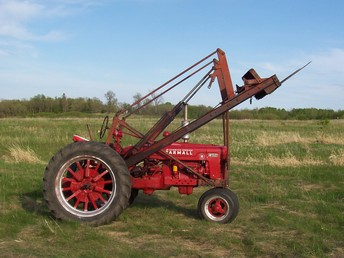Wow! This one stirred up a lot of answers!
I spent the first 35 years of my 77 on a dairy farm (about 200 acres) in NJ. In the late 30s and through the 40s, we used a 10-20 and an F-12, and sometimes got to use a neighbor's H and "Regular" Farmall, as well as an F-20 of a relative. In the early 50s, my father bought a somewhat-tired H to replace the aged 10-20, and ten years later, replaced that with another H that wasn't so tired.
I think, first of all, that the name "Farmall" tells us something. The original Farmall was supposed to do everything that horses could do, and I guess that was true. A quick run through the early Farmall sales catalog shows all kinds of attachments. I believe the most important in the minds of the designers was the cultivator. IHC made several kinds of attached cultivators for use in many different crops (corn, potatoes, cotton, for example). There were attached plows and listers. There was an attached mower, a front-loading hay sweep, and that's where my memory stops in this list.
On an eastern dairy farm, the actual amount of land to be plowed each year wasn't enormous--maybe fifty acres total. The rotation system was the reason for this: Corn the first year. Disk up and plant a grain + grass seed in the fall. Harvest the grain the following summer, and then hay for a few seasons after that. When the hay got to producing poorly, you started all over again.
There is an old formula for plowing and other work that is interesting and useful: width of implement times mph = acres worked in an 8-hour day. A plow 2' wide at 3 mph = 6 acres in an 8-hour day. In our soils, neither of the Hs would pull a 2-12" or 2-14" plow in any higher than second gear (specs say 3.5 mph). Calculation gives 2 ft. X 3.5 = 7 acres in 8 hours. That sounds about right. Here it's appropriate to make some comments about the H as a puller. It was supposed to be a "full 2-plow tractor," which means it replaced the F-20 or the 10-20. Well, sorta. The H had a smaller, faster-revving engine than those oldies, so there wasn't much torque. If you got pulled down in a hard spot, the tractor would slow way down. I have occasionally had to go to first gear when there wasn't enough torque to keep the engine speed up. An F-20 or 10-20, with their huge engines, would just go right on through. The same thing is probably true on the belt. Our 10-20 was a real puller on a thresher, and so was the F-20 we sometimes used. We didn't have an H when we were still using a thresher (up until about 1943), so I can't comment, but I'd guess that it would pull just fine (22" thresher) unless somebody overloaded the feeder.
Like the Farmall, the H had a full-line of attachable implements. Unlike the Farmall and F-20, the H was a pretty comfortable tractor for its day. Nice platform, nice seat, well-placed pedals, good placement of steering wheel, good visibility. Steering was easy enough. The earlier Farmalls were heavy and clumsy, but the H was lighter by almost 800 pounds, so it was a much nicer "chore" tractor (hauling, spreading manure, for example). Since it was comfortable and fairly easy to get on and off, and it was SOOOOOOOOO incredibly pretty, you actually wanted to use it whenever you could. Because the engine was not so big, and fourth gear could be used at part-throttle for light work (pulling a spike-toothed harrow comes to mind), it was probably more economical than an F-20. In many ways, it was more like an F-14 than an F-20, and some people even claim that IHC told dealers to sell the H as a replacement for the -12 and -14. Maybe they did. The sales literature I have from the 40s just says that it will pull two 14" plows under average conditions.
One thing I didn't always like was that very fast fifth gear. On the rough gravel roads of the 30s and 40s, and over the trails that we used to call roads through the fields, you couldn't pull much of anything in fifth because there wasn't enough torque to throttle back to 5 or 6 mph. Fourth gear would give you something close to 6 mph, but with the engine roaring wide open. John Deere and Oliver (70) both had six gears, with fifth being somewhere around 8 mph. If you throttled back in that gear, you could get your 6 mph with pretty good torque. I always suspected IHC engineers wanted to save a little money on expensive gears (fifth on the H and M is just a dog-clutch, similar to the old third gear on 3-speed auto transmission). Maybe it just shows that designers don't always use their products enough, or long enough, to get a good feel for how they will work in all conditions.
I don't have much use for a tractor anymore, except for keeping a small field in front of my house clear of weeds (I use a little Ford that has about the hp of a Cub--can I admit that I have something blue?), but if I could use an H, I'd love to have one. Actually, I think a Super H would be even better--live hydraulics, battery ignition, slightly faster ground speeds(fourth was moved up a bit to give a decent hauling speed over gravel roads).






